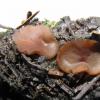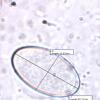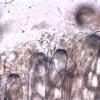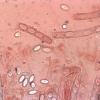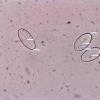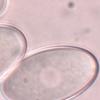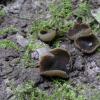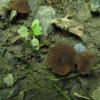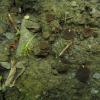
12-12-2025 18:39
Mirek GrycHello everyone.Macrofeatures similar to Mollisia b

09-12-2025 12:06
 Andgelo Mombert
Andgelo Mombert
Bonjour,Je recherche l'article concernant Hypobryo

07-12-2025 16:07
Arnold BüschlenHallo, ich habe in einer Moos-Aufsammlung (epiphy

08-12-2025 21:04
Mark Stevens"Hello everyone,I'm relatively new to microscopy (

08-12-2025 18:59
 Lothar Krieglsteiner
Lothar Krieglsteiner
.. found by a seminar-participant, I do not know t

08-12-2025 17:37
 Lothar Krieglsteiner
Lothar Krieglsteiner
20.6.25, on branch of Abies infected and thickened
Can anyone suggest what this might be.
Thanks
Mal

Hello Mal,
as you wrote, the asci wall stains blue. This feature is quite rare feature in discomycetes - except of the large genus Peziza. Possibly, one of the specialists will tell you the species, too.
Regards from Lothar

this is what I know as Peziza sepiatra. Smooth spores around 20-22x11-13µm and swollen paraphyse tips (sometimes curved) are typical for this species.
regards,
björn
Mal

Hello,
hmmm, but the colour leaves some doubt to me, to be honest.
Macroscopically the dark grey-brown hymenium without red hue is significant, and I can't recognize this typical colour in Mal's foto. Also the excipulum should be contrasting pale grey or even whitish-grey and should be smooth. The paraphyses have usually pigmentation droplets in the upper part.
Not that I have a better idea though ....
best regards,
Andreas

Hi Andreas,
ich bin vollkommen Deiner Meinung. Als sepiatra würde ich einen Pilz dieser Farbe niemals bestimmen. ich halte mich aber mit einem anderen Vorschlag genauso zurück wie Du :-)
Lieben Gruß von Lothar

Dear Mal,
after thinking a bit about your Peziza, I would now suggest that this is likely to be Peziza granularis. The colour would be o.k., spore sizes does fit and the hooked paraphyses are also present in P. granularis. They should be a bit more bent, but in Peziza sepiatra they are definitely straight.
P. granularis is not rarely misidentified as P. sepiatra, as it is very likely in Fungi of Switzerland . Though the paraphyses tips depicted there suggest P. sepiatra, the macroscopic description ("excipulum in same colour or darker" "exterior granulose") and also the foto with the crenulate margin points towards P. granularis.
best regards,
Andreas

I did not compare the details (no time at the moment), but P. granularis would at least have the right color :-)
Regards from Lothar
Mal

mich würde abschließend noch interessieren, wie der "richtige" P. sepiatra makroskopisch aussieht, wenn er farblich schon so unterschieden sein soll. P. sepiatra habe ich erstmalig von Kasparek 2004 gezeigt bekommen und mir das Bild eben eingeprägt. Vermutlich war das damals auch schon P. granularis, ich hab da leider noch nicht mikroskopiert.
Das Problem mit den Paraphysen ist mir aber nicht neu, wir haben im BL sehr viele Funde dieser Art mit teils geraden, teils aber auch gebogenen Paraphysen, während makroskopisch keinerlei Unterschiede in Form, Farbe oder Granulation festzumachen sind. Ich würde die Paraphysen daher nicht als relevantes Unterscheidungsmerkmal nutzen wollen. Vielleicht kann einer von euch mir ein Bild von P. sepiatra zusenden.
lg björn

Hallo Björn,
ich hoffe, die Aufsammlung anbei aus dem NP Eifel ist richtig bestimmt. Peziza ist für mich auch immer ein "Minenfeld". Ich denke aber, sie sollte farblich eher passen. Ich bin leider kein guter Fotograph, die Bilder sind nur so la la.
Herzliche Grüße von Lothar

vielen Dank für die Fotos. Die entsprechen so in etwa meinem aktualisierten Bild von P. sepiatra, dazu habe ich auch noch Bilder von Henk (Huijser) und Medardi vergleichen, die jeweils eine sehr dunkle olivbräunliche Art mit hellem Rand zeigen.
Mit etwas Akribie ist Peziza durchaus zu bewältigen, nur schafft man es kaum, soviel Engagement bei einem so breiten Bearbeitungsfeld wie den Ascomyzeten aufzubringen. Da werden hin und wieder manche Gattungen einfach vernachlässtigt (dazu zählen zb Peziza, Octospora und Hymenoscyphus) und die Funde in eine bestimmte Schublade gesteckt. Ich denke, wir hatten im BL durchgängig nur P. granularis, die sodann wohl auch die häufigere Art zu sein scheint.
lg björn

Hallo Björn,
ja - das mit der Akribie stimmt. Die leidet bei mir gerne mal, da ich halt alle Pilze anschaue. Und mit der Seltenheit von P. sepiatra hast Du meiner Meinung nach recht - ich fand sie sicher nur das eine Mal, P. granularis schon etwas öfter.
Viele Grüße von Lothar
